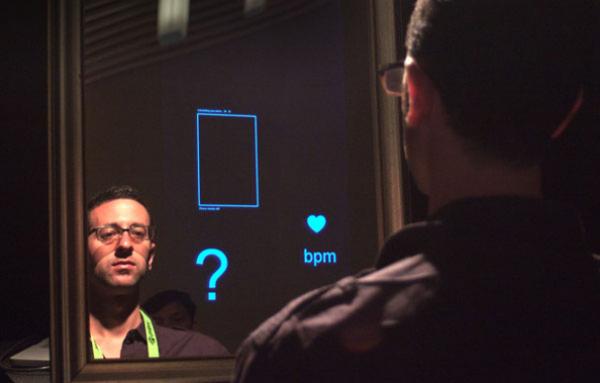New Health-Monitoring Mirror Displays Heart Rate

VANCOUVER, BRITISH COLUMBIA -- Mirror, mirror on the wall, who has the lowest resting heart rate of them all?
OK, so it may not be enough to provoke revenge plots against Snow White, but that doesn't mean the Cardiocam mirror isn't useful in its own way. The reflective device, which debuted here at the SIGGRAPH interactive technology conference, measures and displays the heart rate of whoever gazes into its shiny surface, allowing users to review some of their health metrics during their regular morning hygiene routine.
The Cardiocam mirror, designed by students at the MIT Media Lab, uses a webcam to record the minute changes in skin tone that occur as facial capillaries fill and empty with the beating of a heart. A computer analyzes the facial color change, and then displays the user's heart rate on the mirror. Over time, the mirror establishes a baseline resting heart rate, allowing the user to monitor changes in their cardiac health over time.
"It motivates people when they see their heart rate," said Ming-Zher Poh, a Ph.D. candidate at MIT and the lead designer on the project. "It links in with the gamification of health, and lowers the adoption barrier for exercise."
For the most part, people don't know their own resting heart rate. 60 to 80 beats per minute is considered healthy. Athletes' enhanced ability to process oxygen often leads to heart rates lower than 60 (this author registered 47 beats per minute), and anything above 100 puts one at risk for a heart attack.
But more important than the absolute number is the change. A rising heart rate indicates stress or a creeping lack of health, while a diving heart rate could indicate success at exercise. Both are important, Poh told InnovationNewsDaily, as constantly looking at a lowering heart rate encourages people to continue exercising, while noticing their heart rate steadily increasing could alert users to physical or mental health problems.
Right now, the mirror can only read heart rate, and does not measure any other health indicators. But in the future, the bathroom mirror could easily become the centerpiece of the at home health management system, displaying cholesterol levels while you floss and BMI while you brush your teeth.
Sign up for the Live Science daily newsletter now
Get the world’s most fascinating discoveries delivered straight to your inbox.
This story was provided by InnovationNewsDaily, a sister site to Live Science. Follow InnovationNewsDaily on Twitter @News_Innovation, or on Facebook.









